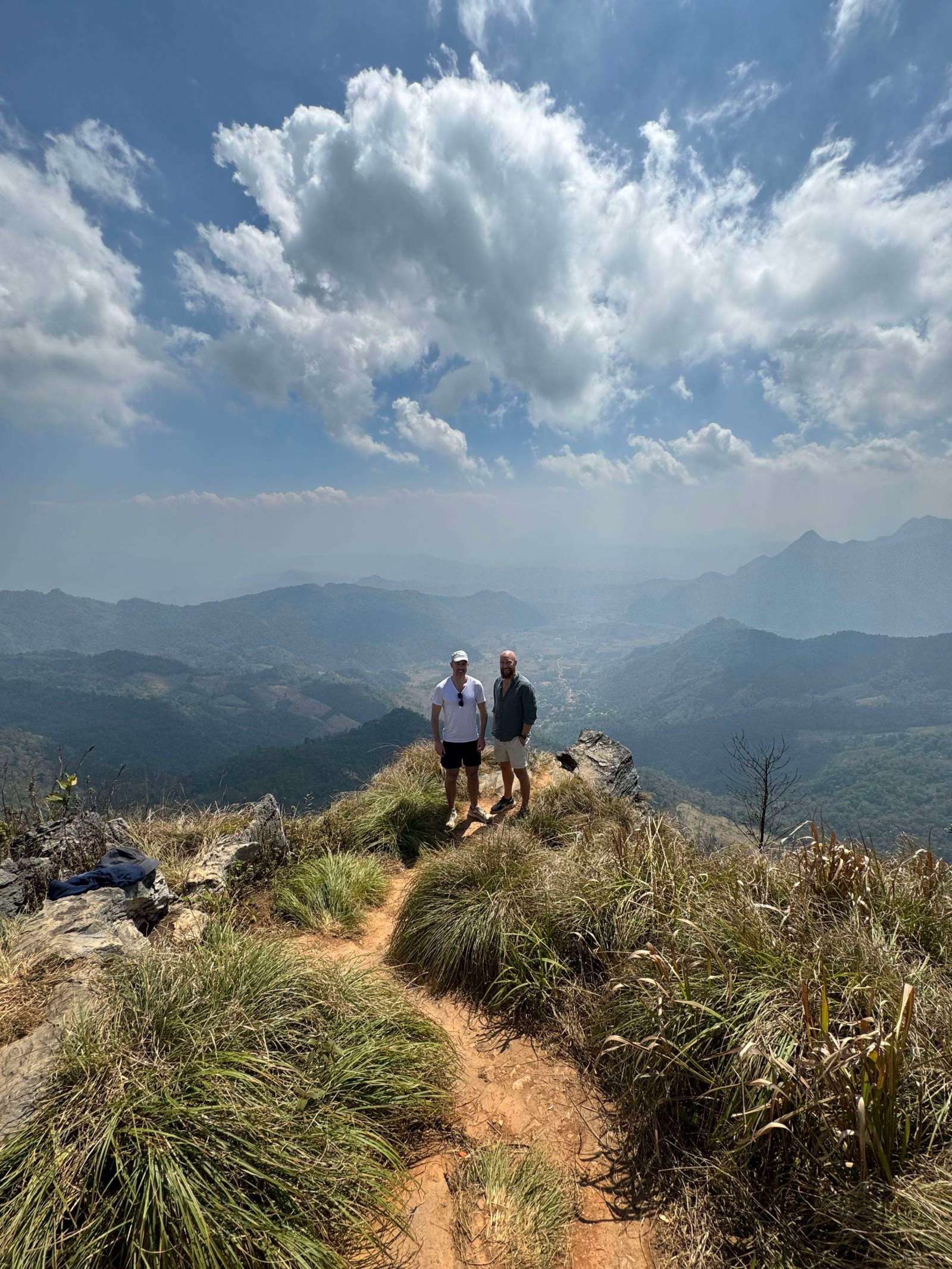
The Lonely Planet categorises the drive from Chiang Kong to Phayao as Thailand’s most stunning route, and I’d have to agree. This dramatic road hugs the steep mountainsides along the Thai-Laos border passing waterfalls, sensational vistas both into Thailand and Laos, and various national parks. I’m sure you could easily do it as a tour, but its way more fun to hire some mopeds and zip along at your own pace, especially considering the hundreds of great turns and the surprisingly high quality of the roads
Top tips:
- The mopeds – you can hire them from just about anywhere when in Thailand. We rented ours from ST Motorcycle & Car Rental in Chiang Mai and would really recommend (bikes were great, and, when I realised I’d lost the petrol cap somewhere, they were super chilled). You fill up on petrol anywhere along the way, typically just via people on the street with coke bottles full of petrol, and its really cheap considering how small the bikes are
- The route – the highlights were basically the various mountain viewpoints all along the 1093 from Phu Pha Tang down to the Phu Sang National Park where the waterfall is. This will take you only around 1.5 hours of driving, but you’ll want roughly 45mins to walk up to the viewpoint of Phu Chi Fah, time for lunch (there are lots of great places with views all along the route), and say 30mins so see the waterfalls
- The route from Chiang Rai – its not ideal, because you have to drive over to the border ridge area and then back again, but very doable in a day. In fact, the views of the hills along route 4029 are worth the trip alone. I’d recommend a bit of a circular route: make your way via the AH3 to join the 1155; then take the 4029 until you hit the 1093 where you can take the standard mountain ridge-hugging route. Once you finished with the waterfall, just use google maps to direct you back to Chiang Rai in what should be a much more direct route that passes through some nice villages
- The roads – we were blown away by how good they were considering how remote the route is, and, considering February is the dry season, its about as good as it gets
- Chiang Rai – is all about the surrounding area, rather than the town itself. So it’s more of a base to be able to head off on nearby adventures. That being said, its got some nice temples and the night market is definitely worth checking out. We stayed at the Mora Boutique Hotel, and would recommend

The countryside around Chiang Rai is some of the prettiest in Thailand, and January / February time is PERFECT for hiking and staying overnight in one of the nearby villages. The combination make this worth doing (I really was blown away by how nice the weather is Northern Thailand at this time of year), but note that the countryside is more on the pretty side rather than the dramatic side. Over the border in Loas is more spectacular
High-level tips:
- Go with the 2 days trip – 1 day would just be a bit rushed once you factor in the transport, hiking, food etc, plus you won’t get that sunset feel of being in the village. 3 days – whilst there is a lot of countryside, you’ll see that it is the same few highlight spots that get called out and 3 days will feel quite samesy
- I’d recommend going with Bamboo Tours – we actually went with Rai Pian Karuna, who were well organised and nice but, as with so many of these things, our experience depended on the guide who unfortunately wasn’t great. After doing a bit of research, Rai Pian Karuna tend to simply get people from the villages (often with very poor english) to walk you from drop off to their village and cook for you at home – which is nice, but it felt a little bit of a waste compared to having a proper guide who showed you more. Note that Bamboo Tours rated 5/5 on Tripadvisor, whereas Rai Pian Karuna 4.2/5. Certainly, not the be-all-and-end-all, but indicative. Both were around 3000B (USD80)
- Try to go October to February – the weather is just perfect, with dry heat, bright blue skies, cool mornings and evenings, and hit afternoons. Plus, March is when they start the burning and you don’t want to be there for that
- Chiang Rai itself is nice as a base, but no more – yes it has the temples and market, yes it has some nice hotels for recharging, but you are there for the surrounding countryside
- The highlight of the nearby area for us was – Mopeds along the Thai / Laos border near Chiang Rai. Spectacular scenery and something fun about zipping about on the windy roads with a moped

Sri Lanka is often described by travellers as “India-light”. It is far more compact, with many of the highlights possible to cover in a week; it has a similar culture in many ways; similar type of experiences on offer, such as tropical beaches, old forts, tea plantations etc; and it is generally a bit less hectic than the madness of a busy India. But, if looking at the flip side, it also doesn’t really offer anything that India doesn’t. So, if you have experience of India, you may find Sri Lanka chilled, pretty, nice to get around, but without necessarily the wow factor. The exception to this though is the Tea Country and the spectacular train ride through it
I’ve listed below the classic, compact 1 week itinerary for some of the highlights and a few high level tips to help you get the most out of the trip:
- Time of year – the experience of Sri Lanka varies dramatically by season. Basically, December to March / April is the best time for this itinerary as it is dry (and nicely cooler) season in the south coast and Hill Country. April to September is best for the north of the country and the Ancient Sites, again because it is drier
- Prioritise time in the Tea Country – the beaches in the south are lovely, Galle is nice for an afternoon, and its worth dedicating half a day to try and see a Blue Whale in Mirissa, but the highlight is the Tea Country for not just the tea estates, but also the hiking and pretty “Old English” feel towns
- Book your trains in advance – you DO NOT want to be standing. I’ve read in a few guide books that it doesn’t really matter if you stand – I think that’s ok for a hour or so, but for longer it really isn’t fun. It’s Sri Lanka – 2nd and 3rd class unreserved will have people crammed in to the point that you can’t sit on the floor and need to stand. Tickets become available 30 days in advance and are super cheap (US$7 for first class just about everywhere), so jump on the train website (really not as bad as people whinge about) or, if left it late, buy at the stations (only the large stations such as Colombo, Kandy and Nanuoya sell reserved seating tickets)
- You’ll want a driver for parts of the trip – some parts of the journey you cannot take a train, such as from Galle up to the Tea Country, and some parts you’ll want a driver to take you around the immediate sites, such as the tea factories and estates. Considering you only have a week, and potentially can share the cost among multiple people, it’s just easier to get a driver for the day. They’re typically US$50 for the day and it also has the benefit of being able to speak in detail with a local as they proudly show you their country. I rented Siri (+94 77 779 8962) for my drive from Mirissa to Ella, who was very knowledgeable; and Yoga (+94 75 165 0205) for around Nuwara Eliya. I’d recommend both
- I wish I’d . . . visited the Uda Walaw National Park. Would have been great to see more of the wildlife, and it fits perfectly into the route
- For more details on each of the experiences, see the detailed travel entries for:
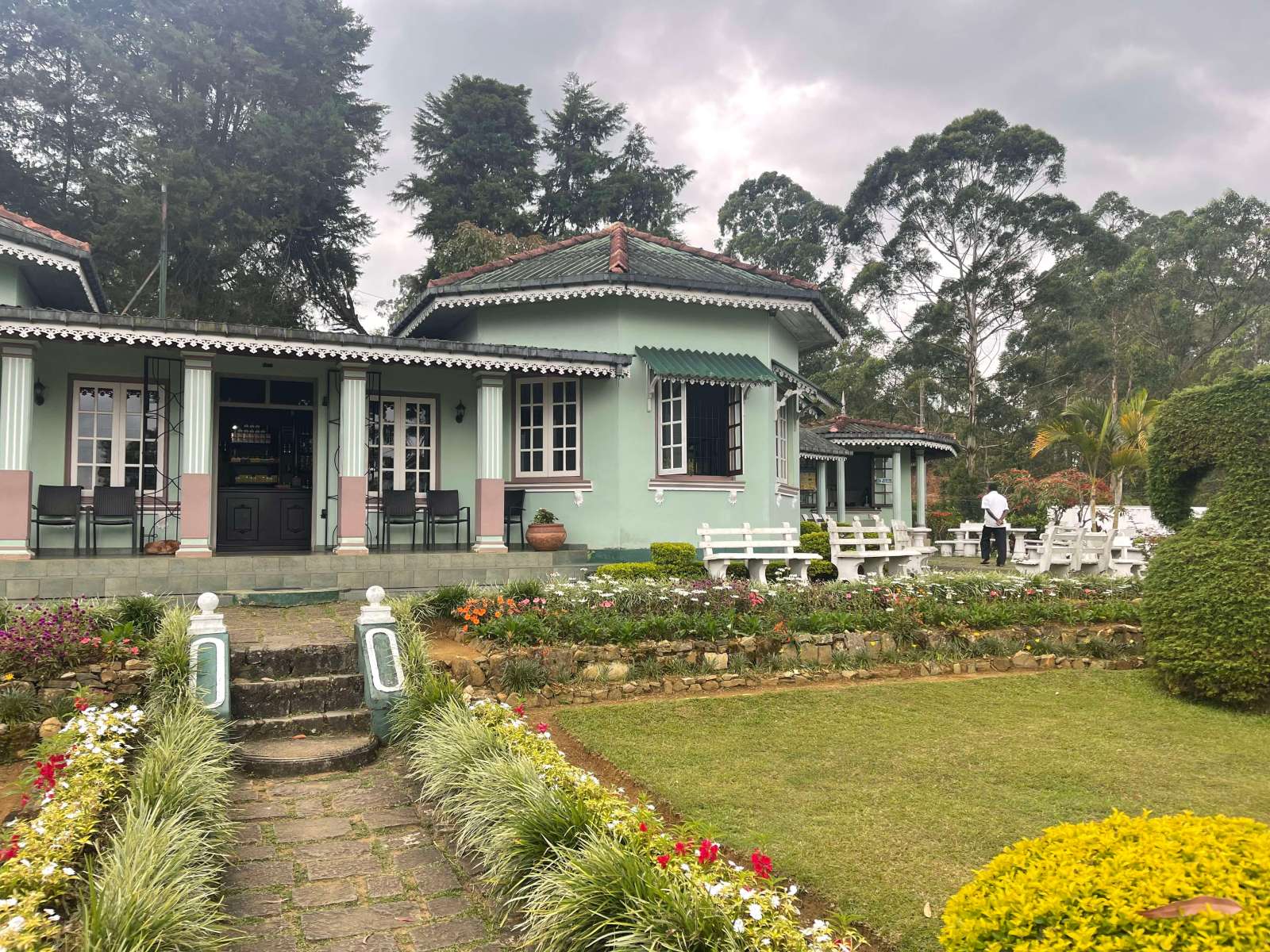
Nestled up in the middle of Sri Lanka’s Tea Country, Nuwara Eliya was one of the old colonial centres for the tea industry and, with the combo of old quaint buildings, race course, golf courses and, well bloody drizzly bleak weather, is affectionally known as “Little England”. As an Englishman I can confirm I felt right at home!
The wandering around the town is nice, as you get to places like the old post office, police station and hotels straight out of a Charles Dickens novel, but it is the surrounding Tea Estates that are the highlight
Top Tips:
1. The drive from Nuwara Eliya to Talawakelle / St Claire Tea Centre is the prettiest for views – its hard to go wrong with the surrounding countryside as it’s all gorgeous, but this is the pick of the bunch. Also, the drive from St Talawakelle to Tawalantenne is dramatic, but super windy and a bit nauseating. For a driver, I went with Yoga (+94 75 165 0205) who was great and charged around US$50 a day
2. Stay in one of the colonial hotels – it will give you the full “Little England” / Old Colonial feel. The Grand Hotel is best for this in the centre; Ferncliff Bungalow for something in the centre that is far quieter but still quintessentially English; and the Amaya Langdale / Oliphant Villa for luxury 20mins or so from the centre
3. Visit one of the Tea Factories – the Damro Labookellie Tea Factory is good for learning about the tea. The Heritance Tea Factory for more style
4. Have High Tea in the Heritance Tea Factory – beautifully restored old Tea Factory that is now a hotel providing luxurious afternoon tea from 3pm onwards
5. The parks are ok for an hour or so – Victoria Park is nice enough to walk through for 30mins, and so is the nearby Galway Land National Park, but have low expectations (highlights are the colonial buildings and tea estates)
6. Wrap up – it gets cold! The don’t call it Little England for nothing – expect drizzle and cold evenings in the winter!
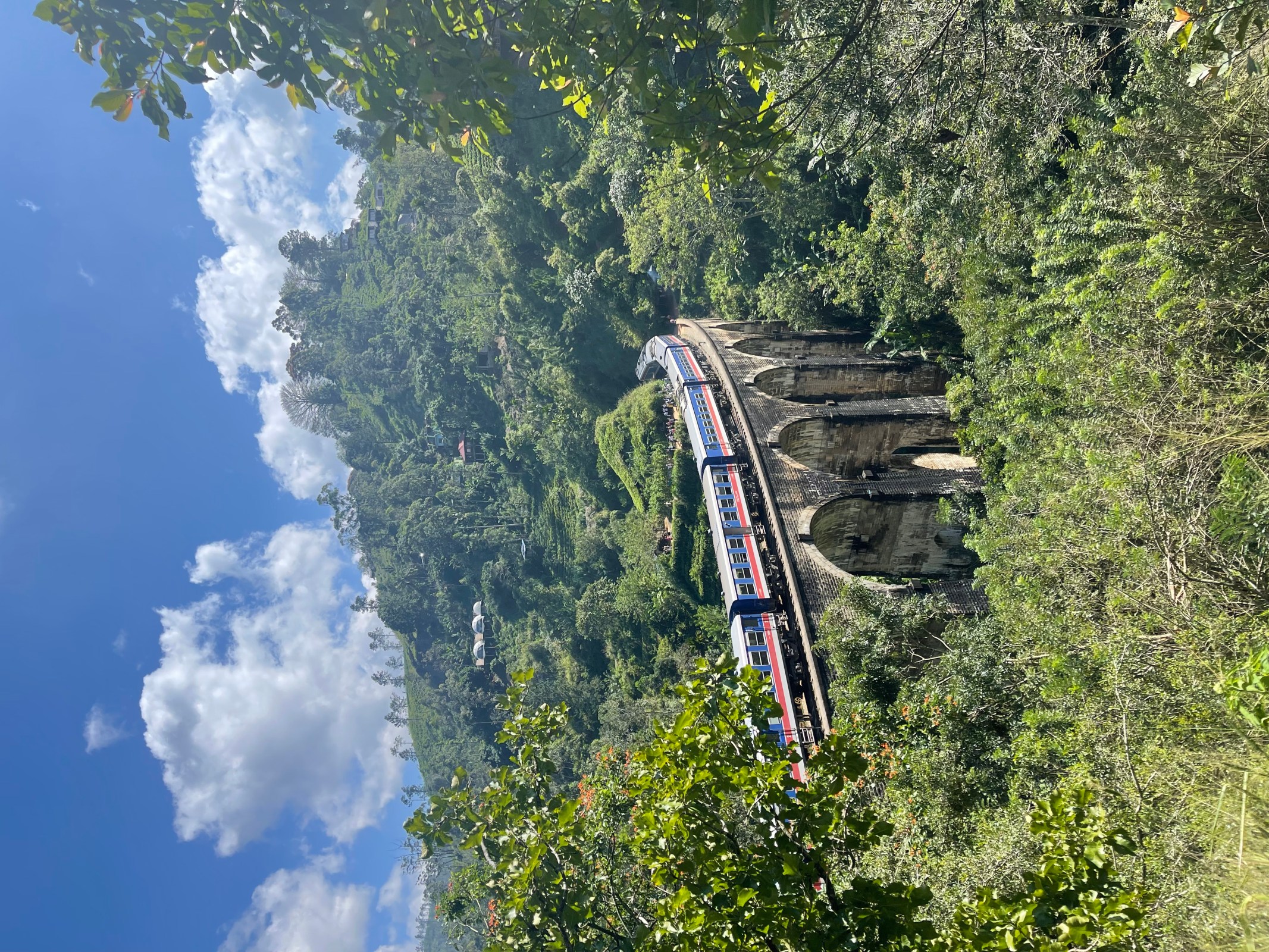
This is the highlight of Sri Lanka. Sitting with the window open as you watch the old train slowly snake its way through hours and hours of beautiful tea plantations that sit within the most dramatic part of Sri Lanka’s Hill Country. You’ll spend the first couple of hours gawping and what feels like endlessly taking photos, and then, after a while, just relaxing and soaking up the peaceful nature of the place, with its quiet towns and tea plantation workers slowly getting on with their day
A few tips to help you get the most out of the trip:
1. What is the route? There is only one train line that goes from Kandy to Badulla, via roughly 20 small/medium stations, but the main ones being Hatton (for Adam’s Peak), Nanuoya (for Nuwara Eliya aka “Little England), Haputale and Ella. The whole route end to end takes 7.5 hours, with just about all of it beautiful except for the section within 1 hour of Kandy, so it doesn’t really matter which section you do – I went from Ella to Nuwara Eliya and then Nuwara Eliya to Kandy and both routes were fab. For a really good breakdown of what to expect, try seat61’s Sri Lanka section (link – https://www.seat61.com/SriLanka.htm#colombo-to-kandy-hatton-nanuoya-badulla-by-train)
2. Make sure you stay in one of the hill towns along the route – its one thing taking the train through the plantations, its another being able to visit and learn about how they make the tea, which you can do in the various “factories” next to the towns. Plus, the surrounding country side of the hillstowns is often beautiful (such as Ella – see a detailed review here – The Hill Country Village of Ella) or just really interesting (such as the “Little England” experience of Nuwara Eliya – see the detailed review here – Staying in Nuwara Eliya’s “Little England”)
3. Book ahead a reserved seat – you DO NOT want to be standing. I’ve read in a few guide books that it doesn’t really matter if you stand – I think that’s ok for a hour or so, but for longer it really isn’t fun. It’s Sri Lanka – 2nd and 3rd class unreserved will have people crammed in to the point that you can’t sit on the floor and need to stand, and you’ll generally have less personal space than you’ll be used to, with locals having significantly better shoving skills than you to get any available seats. Tickets become available 30 days in advance and are super cheap (US$7 for first class), so jump on the train website (really not as bad as people whinge about) or buy at the stations (only the large stations such as Colombo, Kandy and Nanuoya sell reserved seating tickets. You’ll need your passport)
4. Open the window / stand next to an open door for a bit – it just adds so much more to the journey. If next to a window and can open it great. If not, the sections between the trains tend to have the door open so you can look from there. The locals tend to be super accommodating, so if one is already stood at the door, they’ll tend to either welcoming you standing their with them, or move out the way for your 10mins or so
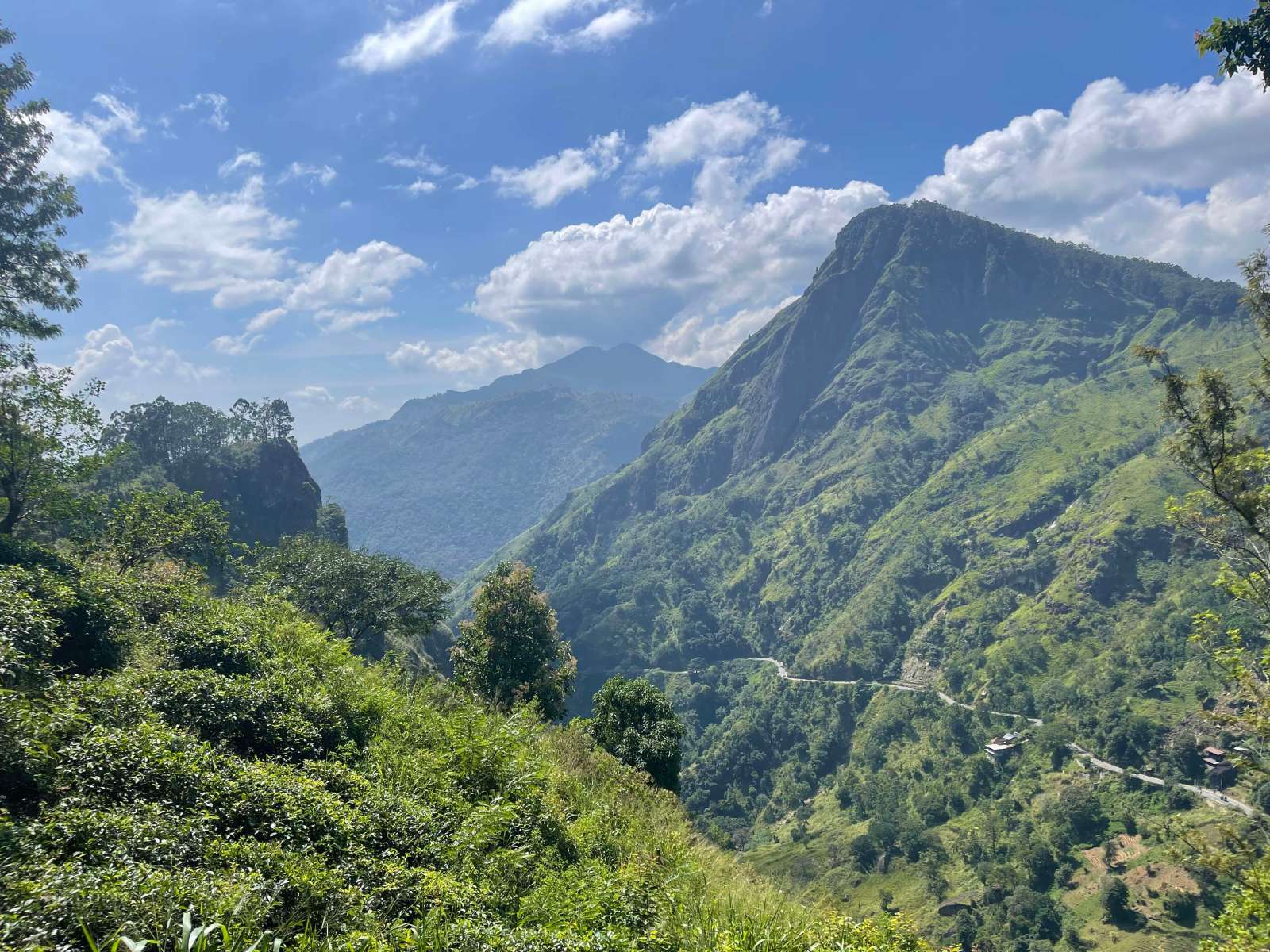
Ella is the prettiest of the towns that are scattered throughout Sri Lanka’s Hill Country, and makes the most sense to start / finish at as part of the wonderful train journey through the tea plantations that most people are here to experience. Definitely worth a day on its own as the mini hikes, tea factories and waterfalls make for a nice day to explore the immediate surroundings, and the town itself is full of restaurants and chilled out guesthouses (typically with great views) to relax after the train journey
Top Tips:
1. Walk to see the Nine Arches Bridge – it’s only a 15min walk from the main road and is just so brilliantly picturesque. See if you can time it so that you are at one of the viewing points in the trees when it passes by and be sure to ask your hotel the time of the train will be as it changes each day
2. Walk up to Little Adam’s Peak – best views across Ella, including through Ella Gap, and only an easy 1.5 / 2 hours round trip. Be sure to start your walk at the main road (at the Ella Flower Garden Resort) rather than drive up to the Ravana Pool or the Flying Ravana Mega Zipline, which is what most people did. The walk from the main road is the prettiest bit as it winds its way through the tea estate and is pretty flat, compared to the steep bit from the zipline area
3. Where to stay – there are HUNDREDS of homestays in and around Ella, so you’ll have a huge variety to choose from. I stayed at the Blooming Rose which has relatively basic rooms, but made up for it with its amazing view through Ella Gap and wonderfully welcoming host family, would very much recommend
4. Restaurants and vibe – Ella has a very backpacker / traveller vibe, so there are plenty of restaurants catering for all that are all within a 2min walk of eachother. Cafe Chill was great as it had both Sri Lankan and Western food to a high standard

Oman is a cracking country for a 5 day trip. It has that wonderful Middle East vibe without the extreme restrictions of the likes of Saudi or Iran, the extreme opulence of the UAE and Qatar, and without the crowds of Egypt and Jordan. To add to the mix, it has a surprisingly diverse offering – world class mountains, vast red deserts, gorge and canyon exploring, and all with the capital Muscat acting as a hub to launch yourself on these adventures
Its only real downsides are that it tends to be expensive; doesn’t have the well trodden traveller path (so you need to do a lot on your own); and, outside of the Hajar Mountains which are sensational, doesn’t have so many of the world class attractions you’ll find in other parts of the Middle East. That being said, the below itinerary was cracking fun
Top tips:
- #1 Prioritise the following 3 things (in order) – 4WD in the Hajar Mountains (including the forts of Nizwa and Bahla as they are en route); Hiking and swimming Wadi Shab; Staying in the red desert of Sharqiya Sands. Muscat only needs a day max and you’ll naturally find this time as you’ll fly in and out of there
- #2 Five days is enough, but with little chill out time – the 3 highlights above are all within 2 hours drive of Muscat and typically only need 0.5 days (Wadi Shab), 1 day (Sharqiya Sands) and 1.5 days (the mountains). Two ways of looking at it:
- If full of energy and trying to get the most out of the 5 days – the itinerary below is very doable and, if slightly impatient, you’ll find that you’ll be done with the places quite quickly (eg you really don’t need more than the morning in Wadi Shab and overnight in the desert). You could even choose between Jebel Shams and the 4WD mountain road to make this a 4 day trip
- If want more of a chill out – either make it a week, or chose between either Jebel Shams (famous) or the 4WD mountain road (spectacular, adventure
- #3 Oman is expensive – it’s quite a shock when you see that the exchange rate is 3US$ to the Omani Rial . . . as in, the other way around!! Everything is more expensive than you’ll likely be used to, so it pays to scan for in particular cheap accommodation and a decent deal on the 4WD
- #4 Driving – you need a car if not on a tour, as public transport is pretty poor. Broadly the deals started at around US$35 / day for a basic rental car, and around 2/2.5 times that for a 4WD – so it may actually make sense to take the 2WD for certain parts and change for 4WD when needed, which is what I did. As always, have a scan on RentalCar to see what the rates look like.
- What about a 4WD? The 4WD makes a lot of the trip easier as you can easily drive up to Jebel Shams, drive to your desert camp in Sharqiya Sands) and is an absolute must for the drive across the mountains via Hatt. That being said, the drive up to Jebel Shams is very doable in a 2WD (no restrictions); you can easily get the Desert Camp to pick you up from the town of Al Wasil or any pre-arranged meeting spot on the main road; and the drive across the mountain road via Hatt can be optional if you’re not up for the nerve jangling. Be sure as well to check that it is a genuine 4WD, rather than a 2WD SUV (which the second rental company were not clear on)
- #5 How to behave / what to wear – Oman felt very much on the chilled out end of the Middle East spectrum, and used to western tourists. Whilst its always better to dress a bit more like a local (they find it odd, for example, that we wear shorts at all), for the itinerary below, there were no places where you would feel uncomfortable wearing clothes showing knees / shoulders
- #6 – for greater detail on individual parts of this trip, see the following travel entries:

Jebel Akhdar (Green Mountain) is the second highest point in Oman and is famous for its otherworldly feel as you rise far above the main Omani valley floors up to the large Saiq plateau 2000m /6560ft above sea level. The experience itself is all about talking short walks through the small gorgeous mountain villages that are connected by the UNESCO World Heritage listed irrigation systems; looking down into the seriously impressive, yet also abundant, canyons; and generally gawping out the window as the stunning mountain scenery passes by. Very much worth the day trip from Muscat
That being said, if you only have a day or two from Muscat to explore the Hajar Mountains, I would prioritise this just behind the very similar drive up to nearby Jebel Shams (see travel entry here – Walking Jebel Sham’s Wadi Ghul canyon). Or, if looking for more of an adventure, the sensational 4WD drive to cross the Hajar mountains via Hatt (see travel entry here – )
Top tips:
#1 Do you need a 4WD – yes. Whilst there is very little need for an actual 4WD, there is a police check point at the start of the drive up to the plateau that checks you have a 4WD. The reason is not because of the road quality (we only drove on paved roads), but because of the long descent down from the plateau and the need to be able to manually change into a lower gear to avoid brakes overheating (yes, I get that you don’t need a 4WD for that, but I doubt you want to argue with the Omani Police)
#2 Be sure to walk part of the Village Trail Hike (W18b). The 4km hike goes between the small mountain villages of Al Aqor and Seeq, but if you don’t want such a long walk (there and back), there is a short gorgeous walk that starts at the official start of the walk (look for “Terraced Fields Viewpoint” or “Dieter’s Point”) and lets you walk through the terraces to the small village of Al-Ain. The walk has amazing views through the canyon, lets you see the irrigation channels and the ornate villages themselves. If you find yourself thinking non of this is clear in the signposting . . . you are not alone. But once you get to the start point (a car park) it is very straightforward
#3 Have lunch at the fabulous Alila Jabal Akhdar – staying at this hotel with its insane views across the nearby canyon will set you back min US$500 / night. Instead, go for lunch which is fairly reasonable (US$40 / head) which will also let you have a wander round
#4 How much time do you need? Its a full day trip from Muscat, with total driving time around 5-6 hours and a total distance of 400km / 250miles. With the walk to the mountain villages, stopping for photos and having lunch you’re looking at around 10 hours or so
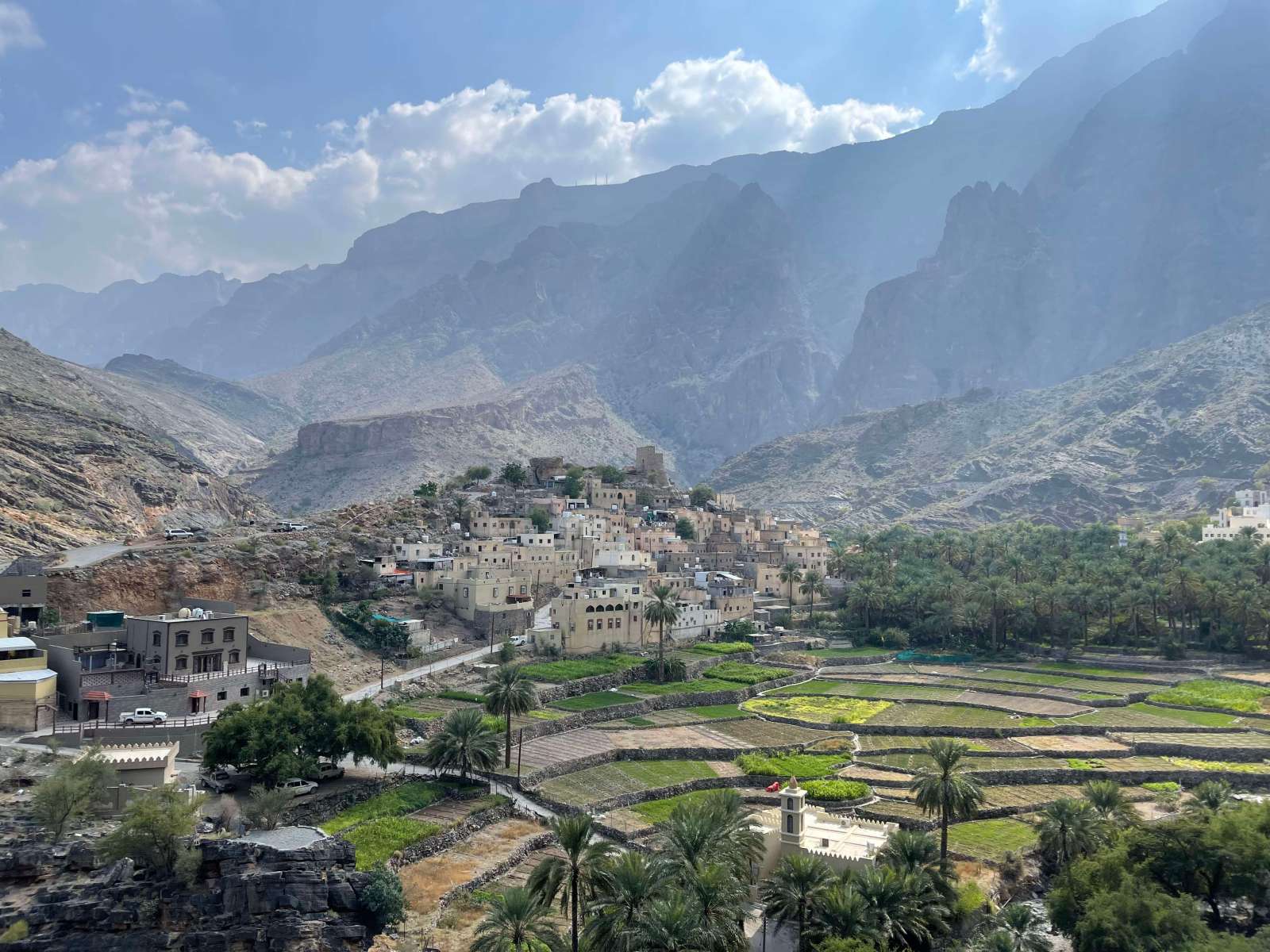
The Hajar Mountains, with their spectacular peaks, hidden hill towns, mini luscious oases and dramatic canyons are some of the most striking mountains in the world and by far the highlight of Oman. Most people visit the forts of Bahla, the Wadi Ghul canyon and drive up to the plateau of Jebel Shams, Oman’s highest mountain – and these really worth doing. But for a truly world-class experience, rent a 4WD and drive the mountain road from Bahla to Rustaq via Hatt. The number of fellow tourists drop off dramatically, the valleys and peaks become more dramatic, the hill towns and oases are significantly more remote and untouched, and above all you’ll have a great feeling of adventure. It’s not for the faint hearted though – the road is challenging, with the majority of your time spent on dirt roads, the drops off the side can be a little terrifying, and at times you will feel a bit isolated with no other drivers around you. But, considering the ease at which you can experience this (easily be done in a day from Muscat and 4WD rentals are easy to rent), this should be right at the top of your list for Oman
Top tips:
- Is the route hard to follow – no. I’ve seen plenty of blogs that make it seem easy to get lost. It really isn’t. I’ve listed below the route to demonstrate some of the things you can expect to see, but you can just plug it into google maps and you’ll have no problems. Even without google maps, its basically a direct road except for 2 forks that are clearly signposted
- Do you need a 4×4 – absolutely. Contrary to many things written about the Jebel Shams ascent, I think you can easily get up Jebel Shams without a 4WD. But you absolutely cannot do this mountain route without a 4WD – that would be dangerous
- Is it dangerous – as long as you (i) have a 4WD; (ii) don’t drive in the rain or when the road is very wet; (iii) don’t be reckless; (iv) use a bit of common sense when other cars are passing, this is not dangerous. That being said, it is challenging and at times nerve wracking just because of the steep sides
- How much time does it take – it took me 3 hours for the drive, including stopping just about every 10mins for photos. I think if you wanted to stop in some of the villages, add on an extra hour on. If you are driving from Muscat, it’s around 1.5hours to Rustaq and around 2hours to Bahla. So, all in from Muscat you’re looking at a 6.5-7.5 hour day
- The obvious stuff – your chances of something going wrong are low, but it always makes sense to prep correctly – reduce the pressure in your tires by around 20% for the offroading; make sure you have enough fuel (there are no petrol stations); make sure you have a spare tire and know roughly how to replace it; bring water in case for whatever reason you do get stuck. Whilst it is quite isolated at times, I saw around 30 other vehicles on my trip (locals and tourists) so you will have support if you run into problems (in fact it will be in their interest to help you if you are blocking the road!)

Jebel Shams is regularly listed as one of the highlights of Oman, and rightly so – the view down into the immense Wadi Ghul is impressive and justifies its tag as the “Grand Canyon of Arabia”. You’ve also got the drive up there with a spectacular mountain landscape that makes it very hard not to stop regularly for photos
There’s a lot of writing about carpet sellers and that sort of stuff, but they’re really only a very minor part of the experience. In reality it’s all about looking over the canyon sides and walking deep into the canyon on the gorgeous Balcony Walk and, if you have a spare day, hiking up to the peak of Jebel Shams itself (3009m / 9872ft)
Top tip #1 – its all about the Wadi Ghul canyon and the Balcony Walk. The maps and general tips for the place can be super confusing. What you are basically looking to do is look over the edge in the Wadi Ghul canyon (Jebel Shams View Point 3 is great for this) and walk the Balcony Walk (aka W6) which is a 1.5-2.5 hour walk (there and back) along a light to moderate slope that starts near the wide point of the canyon (Balcony Walk Guesthouse) and ends at an abandoned village at one of the end points of the canyon (very clearly signposted). Even if you’re not keen on the full walk, it’s still worth just walking the first 15mins or so as that has some of the best views
Top tip #2 – you can drive up to the Jebel Shams plateau without a 4WD. For sure it’s easier in the 4WD, but as long as you are a confident driver and it isn’t raining you will be fine. You’ll have maybe 20 / 30mins of unpaved road, with only a couple of sections you’ll need to pay attention to
Where to stay – I stayed at the Sama Heights Resort, which was really nice and fit in perfectly with the surroundings. It’s only a 5min drive or so to the first views of the canyon










